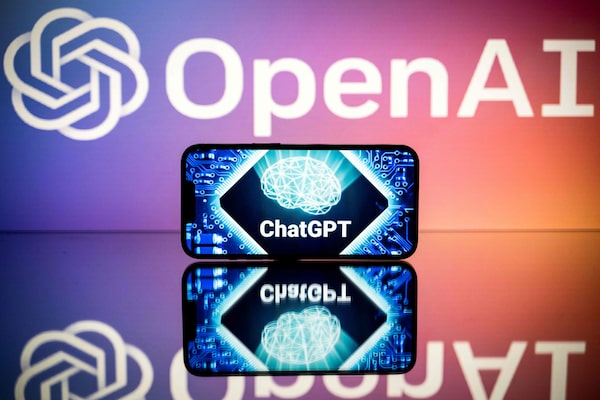
GPT-4 has been widely awaited ever since ChatGPT burst onto the scene in late November, wowing users with its capabilities that were based on an older version of OpenAI's technology, known as a large language model.LIONEL BONAVENTURE/AFP/Getty Images
OpenAI, the company that invented the much-hyped ChatGPT chatbot, has released the latest and “most advanced” version of their artificial intelligence (AI) model.
The GPT-4 language model can “solve difficult problems with greater accuracy,” is more reliable and can handle “more nuanced instructions” than its predecessor system, OpenAI said on its website.
ChatGPT was launched in November 2022 and quickly generated both enthusiasm for its possibilities and criticism about AI systems, including concerns about how to ethically use the program in schools and offices.
Here is a look at what the latest GPT model can do, its limitations, and five practical ways to use the AI technology.
What is GPT-4 and what’s new?
OpenAI says GPT-4 “exhibits human-level performance.”
“It’s not perfect, but neither are you. And together it’s this amplifying tool that lets you just reach new heights,” OpenAI president Greg Brockman said during an online demonstration on Tuesday.
How does it work? Essentially, GPT, which stands for generative pretrained transformer, is an AI model trained to process prompts to perform the tasks at hand, such as answering questions or generating code.
The biggest update is that GPT-4 can see, understand and respond to images. The earlier version was limited to text prompts. The company says that GPT-4 is capable of processing up to 25,000 words – nearly eight times more than its predecessor.
The new system is also “steerable,” which means that instead of getting an answer in ChatGPT’s “classic” fixed tone and verbosity, users can customize it by asking for responses in the style of a Shakespearean pirate, for instance. GPT-4 can also figure out tax deductions, compose songs and write screenplays.
OpenAI, however, has acknowledged that GPT-4 still has limitations and warned users to be careful. The system is “still not fully reliable” because it “hallucinates” facts and makes reasoning errors, the company said.
Here are five things that GPT-4 and its new image capabilities can do
It can turn a hand-drawn sketch into a functional website
During OpenAI’s live demonstration, Mr. Brockman sketched out the design of a basic website on a napkin, took a photo of his drawing with his phone and uploaded it to the GPT system. Moments later, the technology generated HTML code and turned the sketch into a functional website.
I just watched GPT-4 turn a hand-drawn sketch into a functional website.
— Rowan Cheung (@rowancheung) March 14, 2023
This is insane. pic.twitter.com/P5nSjrk7Wn
It can pass standardized tests
According to a report posted on OpenAI’s website, GPT-4 can ace standardized tests such as the SATs and the bar exam. For example, during a simulated bar exam, GPT-4 received a score in the top 10th percentile. In contrast, the previous version scored in the bottom 10th percentile.
🤯🤯Well this is something else.
— Ethan Mollick (@emollick) March 14, 2023
GPT-4 passes basically every exam. And doesn't just pass...
The Bar Exam: 90%
LSAT: 88%
GRE Quantitative: 80%, Verbal: 99%
Every AP, the SAT... pic.twitter.com/zQW3k6uM6Z
It can help you decide what to make for dinner based on a picture
The OpenAI website shows an example where you can upload a photo of food in your pantry or your fridge to help determine what to have for breakfast, lunch or dinner. You can input the photo with the prompt, “What can I make with these ingredients?, and GPT-4 will output a list of recipe ideas.
Here's how I gave GPT-4 an image of my fridge and asked it to come up with recipes. pic.twitter.com/hUOoD9IoRr
— Neural Nut AI (@neuralnutai) March 15, 2023
It can potentially help you find love
Keeper Match, an AI-driven dating site, experimented with using GPT-4 for matchmaking. On Twitter, chief executive officer Jake Kozloski posted a video that demonstrates a user uploading the profile data of two clients to determine if a match would work.
How Keeper is using GPT-4 for matchmaking.
— Jake Kozloski (@jakozloski) March 14, 2023
It takes profile data & preferences, determines if the match is worth pursuing & automates the followup.
With computer vision for the physical, you can filter on anything and find your ideal partner. pic.twitter.com/fdHj1LgUHo
It can recreate your classic childhood games
If you miss playing nostalgic online games, GPT-4 can code one for you. A Twitter user said that they recreated Pong, one of the first computer games ever made, in less than 60 seconds. Similarly, the game of Snake was recreated in less than 20 minutes. Another example on TikTok shows GPT-4 recreating the classic 1970s arcade game Space Invaders within three minutes.
I don’t care that it’s not AGI, GPT-4 is an incredible and transformative technology.
— Pietro Schirano (@skirano) March 14, 2023
I recreated the game of Pong in under 60 seconds.
It was my first try.
Things will never be the same. #gpt4 pic.twitter.com/8YMUK0UQmd
Can GPT-4 code an entire game for you? Yes, yes it can.
— Ammaar Reshi (@ammaar) March 14, 2023
Here's how I recreated a Snake game that runs in your browser using Chat GPT-4 and @Replit, with ZERO knowledge of Javascript all in less than 20 mins 🧵 pic.twitter.com/jzQzSRIkfz
@justjonexplains ChatGPT-4 recreates space invaders in 3 mins #chatgpt #gpt4 #openai #softwareengineer ♬ Spooky, quiet, scary atmosphere piano songs - Skittlegirl Sound
With reports from The Associated Press.